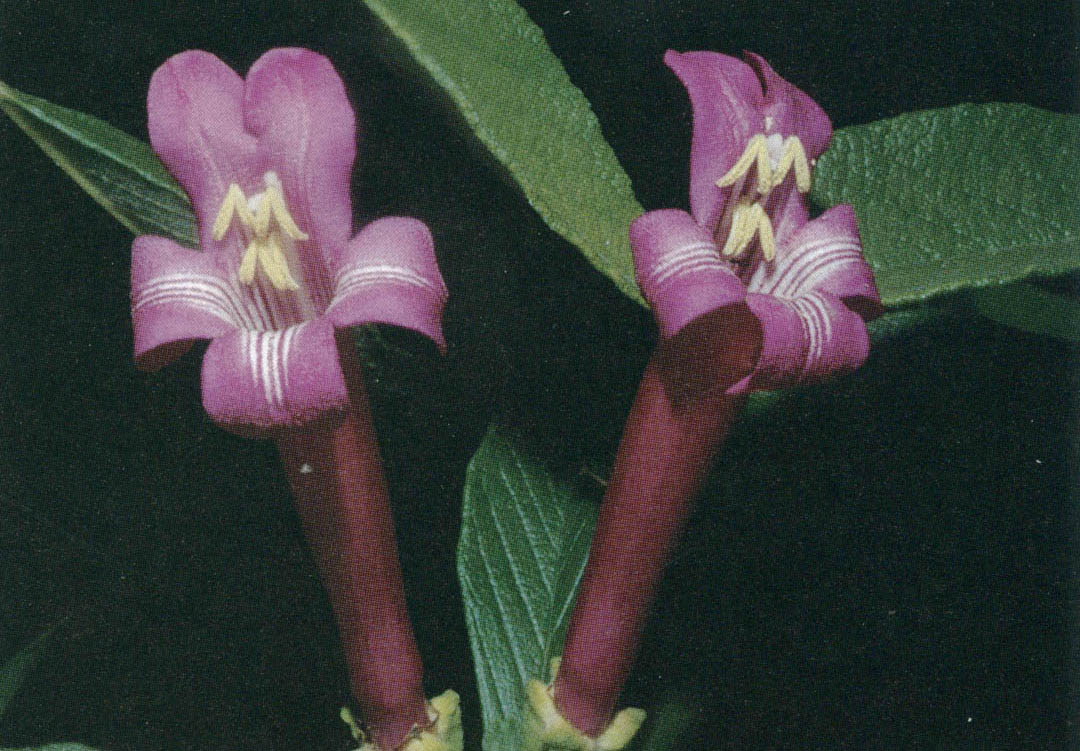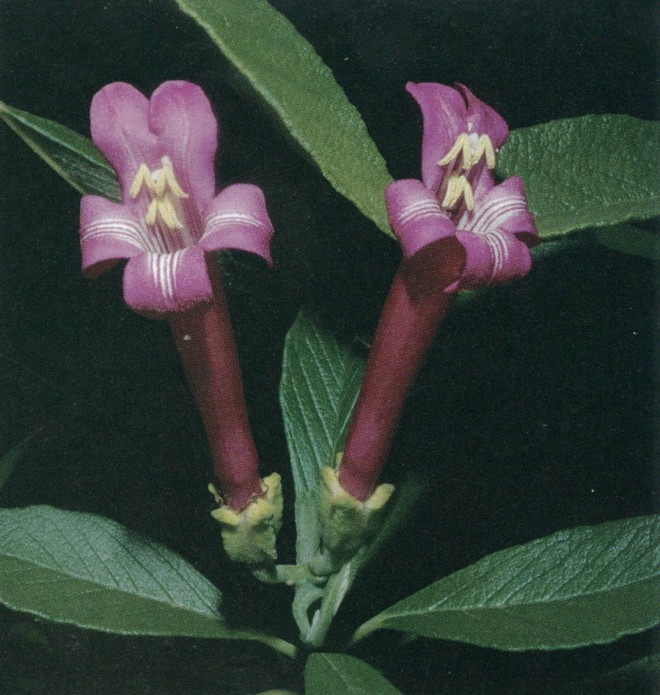

Contributor
- Topics: Archive, Plants You Need

In 1965 we received, from the University of California Botanical Garden in Berkeley, Delostoma lobbii seeds that had been collected in Peru in 1964 by Paul Hutchison. Several seedlings resulted and were planted in various parts of the garden; at least two of the original plants still exist. Over the ensuing years, plants have occasionally been propagated for distribution to other gardens and for sale at our annual plant sales.
A member of the trumpet tree family (Bignoniaceae), Delostoma encompasses only four species, all found in the northern Andes. Two are cultivated here: D. lobbii and D. integrifolium (syn. D. roseum). A third species, D. dentatum, is quite similar morphologically to the first two but is well-separated geographically. Delostoma gracile is known from only a single locality in Peru and is distinguished by long-peduncled racemes of red tubular flowers.
Delostoma lobbii occurs in the dry inter-Andean valleys from southern Ecuador to southern Peru at elevations from 1,550 to 3,250 meters (5,120 to 10,725 feet). There, it is known by the vernacular names montetunya and pichus. The seeds from which our plant resulted were collected at 2,850 meters (9,410 feet) at about 8º south latitude in Río Marañon Canyon in Peru. Though found fairly close to the equator, its elevational range confers some degree of frost hardiness. Even so, our plants are in protected areas and survived the 1990 freeze without any damage. One plant is in full sun, the other in full shade; both seem to grow and flower equally well.
In habitat, Delostoma lobbii is a six- to twenty-foot tall shrub or small tree. In cultivation it has a somewhat lanky or sprawling habit, with many erect or arching branches arising from the base to form a shrub six to eight feet tall by about as wide. Foliage tends to be clustered terminally on short branchlets; leaves are medium to deep green and oblong-elliptic with conspicuously reticulated veins. Each inflorescence consists of one or two tubular, three-inch long flowers. These can be red or magenta with a white throat and are clearly adapted for hummingbird pollination. Our plants have cerise-colored flowers, produced on and off during the year so that there are some flowers on the plant nearly all the time.
Delostoma’s growth habit does not lend itself well to container growing or pruning although experimentation is always encouraged. Many branches arise from the base and some will arch to a considerable spread, so allow enough space or remove the arching branches at the base if desired. Plants grow equally well in sun or shade with weekly watering; in regions cooler than Pasadena, perhaps less water is needed. Our plants tolerate our relatively heavy, poorly draining soil, but better growth will likely be achieved in better soil. Propagation is relatively easy from semi-hard cuttings.
Delostoma lobbii will make an attractive and novel addition to your garden or plant collection.
Share:
Social Media
Garden Futurist Podcast
Most Popular
Videos
Topics
Related Posts

Low Maintenance Gardens – Better for Pollinators and People
Autumn 2022 “I come out every day. It’s therapy, my meditation.” Janet’s young garden transformed from overgrown, invasive plants to mostly natives. The dailiness of

Calochortophilia: A Californian’s Love Affair with a Genus
Summer 2022 I can chart the progression of my life by Calochortus. For the last two decades, at least. As a teenage girl growing up

Pacific Plant People: Carol Bornstein
Spring 2022 Public gardens play a key role in demonstrating naturalistic planting design, selecting native and adapted plants for habitat, and testing techniques for reducing

Add Year-Round Interest and Winter Blooms for Pollinators
Spring 2022 This article was created from an Interview by Merrill Jensen with Neil Bell in the Summer of 2021 for our Pacific Plant People









Responses